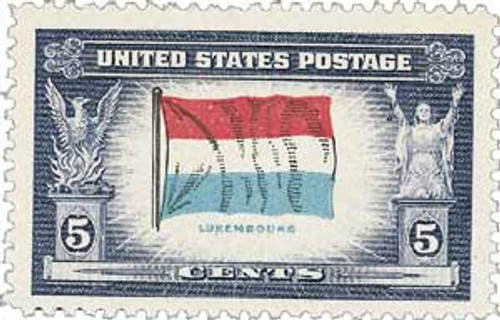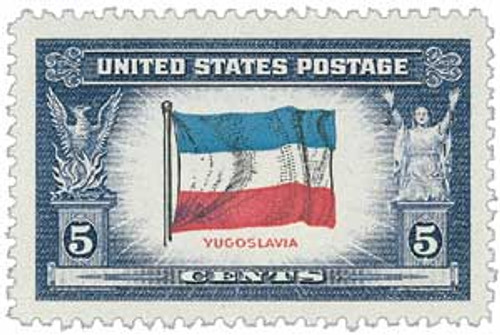
1943 Overrun Countries: 5c Flag of Luxembourg
# 912 - 1943 Overrun Countries: 5c Flag of Luxembourg
$0.35 - $19.95
U.S. #912
5¢ Flag of Luxembourg
Overrun Countries Series
5¢ Flag of Luxembourg
Overrun Countries Series
Issue Date: August 10, 1943
City: Washington, D.C.
Quantity: 19,999,646
Printed by: American Bank Note Company
Printing Method: Flat-Plate
Perforations: 12
Color: Blue violet, dark rose, light blue, and black
City: Washington, D.C.
Quantity: 19,999,646
Printed by: American Bank Note Company
Printing Method: Flat-Plate
Perforations: 12
Color: Blue violet, dark rose, light blue, and black
U.S. #912 is part of the Overrun Countries Series, which honors each of the nations invaded by Axis powers during World War II. It pictures the flag of Luxembourg, which features red, white, and blue stripes, taken from the Grand Dukes coat of arms from the 13th century. The flag was first used in the 1840s, but was not officially adopted until 1972.
Luxembourg History Through World War II
Luxembourg is located in northwestern Europe where Germany, France, and Belgium meet. Siegfried, the Count of Ardennes (a plateau area just north of Luxembourg) built a castle in 963 at the present site of the city of Luxembourg, the nations capital city. In 1308, Henry VII, the Count of Luxembourg, became king of the Holy Roman Empire. In 1354, his grandson Charles IV established the Duchy of Luxembourg. Control of the Duchy passed to Burgundy in 1443, France in 1684, Spain in 1697, Austria in 1714, and then backs to France in 1795. After the defeat of Napoleon Bonaparte, the Congress of Vienna placed the king of the Netherlands, who was also the grand duke of Luxembourg, in charge of the country. When Wilhelmina became Queen in 1890, Luxembourg declared its independence, as its laws prohibited rule by a woman.
Luxembourg was occupied by Germany during World Wars I and II. Much of the fighting in the Battle of the Bulge, which took the lives of thousands of Americans, was fought in the northern portion of this nation. Luxembourg became a member of the United Nations in 1945, and is presently part of the European Community.
These Stamps Brought Hope to Overrun Countries of WW II
After receiving several designs from artists who felt the current U.S. postage stamps were unattractive, President Franklin Roosevelt began to consider the types of stamps he wanted to issue. He sought to show the world that America was in this war to achieve world peace, not military dominance. With this in mind, the President suggested the U.S. issue a series of stamps picturing the flags of all the overrun nations in Europe.
After receiving several designs from artists who felt the current U.S. postage stamps were unattractive, President Franklin Roosevelt began to consider the types of stamps he wanted to issue that. He wanted to show the world that America was in this war to achieve world peace, not military dominance. With this in mind, the president suggested the U.S. issue a series of stamps picturing the flags of all the overrun nations in Europe.
In the border surrounding each flag, Roosevelt suggested picturing the Phoenix an ancient symbol of rebirth. He believed it might tell those suffering victims in Europe that we are struggling for their own regeneration.The other side of each flag pictured a kneeling woman breaking the shackles of oppression.
When the time came to print the stamps, the Bureau of Engraving and Printing was unable to print the multiple colors needed for each flag, so the American Bank Note Company received a special contract for this series.
Additionally, a 5¢ denomination the foreign rate for first class postage was chosen so the stamps could be used on overseas mail. The stamps were printed in relatively small quantities and were in high demand as soon as they were issued, with stocks across the country running out almost as soon as they were released.
FDR The Stamp-Collecting President
President Franklin Roosevelt was instrumental in the design and issuance of U.S. #912. Franklin Delano Roosevelts mother introduced the future President to stamp collecting at a young age. Throughout his life, he turned to his collection to relax and unwind.
Roosevelt was elected President four times, serving in the nations highest office longer than any other chief executive 12 years. During those 12 years, Roosevelt promoted the importance of stamps by personally approving each of more than 200 stamp designs. This included suggesting topics, rejecting others, and even designing some of the stamps himself. He used U.S. postage stamps to educate Americans about their heritage, to buoy war-weary spirits during World War II, and to send a message of peace and hope as Europe faced the overwhelming task of rebuilding.
U.S. #912
5¢ Flag of Luxembourg
Overrun Countries Series
5¢ Flag of Luxembourg
Overrun Countries Series
Issue Date: August 10, 1943
City: Washington, D.C.
Quantity: 19,999,646
Printed by: American Bank Note Company
Printing Method: Flat-Plate
Perforations: 12
Color: Blue violet, dark rose, light blue, and black
City: Washington, D.C.
Quantity: 19,999,646
Printed by: American Bank Note Company
Printing Method: Flat-Plate
Perforations: 12
Color: Blue violet, dark rose, light blue, and black
U.S. #912 is part of the Overrun Countries Series, which honors each of the nations invaded by Axis powers during World War II. It pictures the flag of Luxembourg, which features red, white, and blue stripes, taken from the Grand Dukes coat of arms from the 13th century. The flag was first used in the 1840s, but was not officially adopted until 1972.
Luxembourg History Through World War II
Luxembourg is located in northwestern Europe where Germany, France, and Belgium meet. Siegfried, the Count of Ardennes (a plateau area just north of Luxembourg) built a castle in 963 at the present site of the city of Luxembourg, the nations capital city. In 1308, Henry VII, the Count of Luxembourg, became king of the Holy Roman Empire. In 1354, his grandson Charles IV established the Duchy of Luxembourg. Control of the Duchy passed to Burgundy in 1443, France in 1684, Spain in 1697, Austria in 1714, and then backs to France in 1795. After the defeat of Napoleon Bonaparte, the Congress of Vienna placed the king of the Netherlands, who was also the grand duke of Luxembourg, in charge of the country. When Wilhelmina became Queen in 1890, Luxembourg declared its independence, as its laws prohibited rule by a woman.
Luxembourg was occupied by Germany during World Wars I and II. Much of the fighting in the Battle of the Bulge, which took the lives of thousands of Americans, was fought in the northern portion of this nation. Luxembourg became a member of the United Nations in 1945, and is presently part of the European Community.
These Stamps Brought Hope to Overrun Countries of WW II
After receiving several designs from artists who felt the current U.S. postage stamps were unattractive, President Franklin Roosevelt began to consider the types of stamps he wanted to issue. He sought to show the world that America was in this war to achieve world peace, not military dominance. With this in mind, the President suggested the U.S. issue a series of stamps picturing the flags of all the overrun nations in Europe.
After receiving several designs from artists who felt the current U.S. postage stamps were unattractive, President Franklin Roosevelt began to consider the types of stamps he wanted to issue that. He wanted to show the world that America was in this war to achieve world peace, not military dominance. With this in mind, the president suggested the U.S. issue a series of stamps picturing the flags of all the overrun nations in Europe.
In the border surrounding each flag, Roosevelt suggested picturing the Phoenix an ancient symbol of rebirth. He believed it might tell those suffering victims in Europe that we are struggling for their own regeneration.The other side of each flag pictured a kneeling woman breaking the shackles of oppression.
When the time came to print the stamps, the Bureau of Engraving and Printing was unable to print the multiple colors needed for each flag, so the American Bank Note Company received a special contract for this series.
Additionally, a 5¢ denomination the foreign rate for first class postage was chosen so the stamps could be used on overseas mail. The stamps were printed in relatively small quantities and were in high demand as soon as they were issued, with stocks across the country running out almost as soon as they were released.
FDR The Stamp-Collecting President
President Franklin Roosevelt was instrumental in the design and issuance of U.S. #912. Franklin Delano Roosevelts mother introduced the future President to stamp collecting at a young age. Throughout his life, he turned to his collection to relax and unwind.
Roosevelt was elected President four times, serving in the nations highest office longer than any other chief executive 12 years. During those 12 years, Roosevelt promoted the importance of stamps by personally approving each of more than 200 stamp designs. This included suggesting topics, rejecting others, and even designing some of the stamps himself. He used U.S. postage stamps to educate Americans about their heritage, to buoy war-weary spirits during World War II, and to send a message of peace and hope as Europe faced the overwhelming task of rebuilding.



















